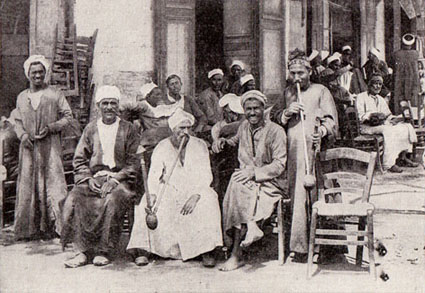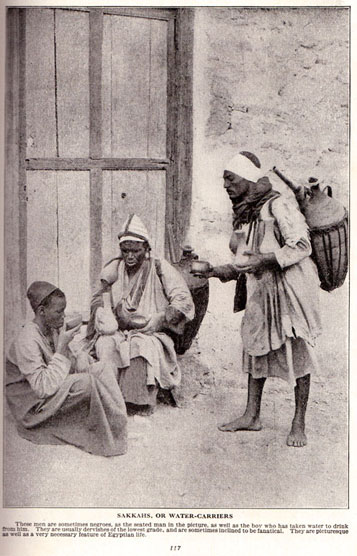
“These cafes are picturesque places where one sees the street life of Cairo at its best. Note the more humble style of Turkish pipe smoked by this Arab without being set on the floor.
Exactly 90 years ago a four-volume set of encyclopedia-like human interest books was published as The Human Interest Library: Visualized Knowledge by Midland Press in Chicago. In a previous post I commented on its thoroughly “Orientalist” flavor. The section on Egypt covers mainly the archaeological history with only a few brief comments on the then contemporary state of Egypt. On one plate (volume 4, p. 114) there is a photograph of “An Arab Cafe” (shown above) underneath one of the mummy of Sethi the First. There is also a scene of two water carriers (shown below).

“These men are sometimes negroes, as the seated man in the picture, as well as the boy who has taken water to drink from him. They are usually dervishes of the lowest grade, and are sometimes inclined to be fanatical. They are picturesque as well as a very necessary feature of Egyptian life.”
It is not until the last page of the article that “Egypt today” is uncovered. Not surprisingly, the Pharaonic past is for more than prologue here:
Egypt today, as the case with most of these ancient countries is merely the shadow of its former self; its inhabitants lack the energy and popwer which seem to have belonged to their ancestors. The French some years ago constructed the Suez Canal and on a sandbar which was built up from the the dirt out of the canal the modern city of Port Said was located. It is in some ways the most cosmopolitan city in the world being the gateway between the Occident and the Orient. In visiting Egypt the former usually lands at Port Said or Alexandria, then there is a ninety mile trip by rail to the city of Cairo. It seems quite odd to be riding by street car the six miles out from Cairo to the pyramids. It seems such an awe-inspiring thing to connect these ancient monuments with such a modern achievement. It is, however, typical of Egypt today in that ancient and majestic relics are on the one hand in contrast with the impudent signs of modern native life on the other; the little Bedouin children plan and the burros graze over spots the penetration of the sanctity of which once demanded the penalty of death.
Ah, the sentiments of the Occidental tourist in an antique land where the “impudent signs of modern native life” mar the view of ancient relics. Selah.